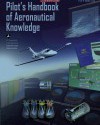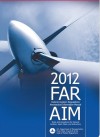If you want to save a few dollars on flight training consider using the following materials for study. These materials will prepare you for the written portions of your Private Pilot Training. Always work with a Certified Flight Instructor!
- The FAA Official Student Pilot Guide This PDF document is the Federal Aviation Administrations official training manual for student pilots. It is not the only source for training materials but it is the official manual the exams are based upon. Consider this the alternative to the Jeppesen Flight Training Manual.
 The Pilot’s Handbook of Aeronautical Knowledge provides basic knowledge that is essential for pilots. This handbook introduces pilots to the broad spectrum of knowledge that will be needed as they progress in their pilot training. Except for the Code of Federal Regulations pertinent to civil aviation, most of the knowledge areas applicable to pilot certification are presented. This handbook is useful to beginning pilots, as well as those pursuing more advanced pilot certificates. Other useful website exist to help explain the information . Consider visiting www.pilottutor.org to enhance your understanding of these various Aviation Related topics. It has animated training for VFR and IFR pilots. The web site design is very basic but effective.
The Pilot’s Handbook of Aeronautical Knowledge provides basic knowledge that is essential for pilots. This handbook introduces pilots to the broad spectrum of knowledge that will be needed as they progress in their pilot training. Except for the Code of Federal Regulations pertinent to civil aviation, most of the knowledge areas applicable to pilot certification are presented. This handbook is useful to beginning pilots, as well as those pursuing more advanced pilot certificates. Other useful website exist to help explain the information . Consider visiting www.pilottutor.org to enhance your understanding of these various Aviation Related topics. It has animated training for VFR and IFR pilots. The web site design is very basic but effective.- The Aeronautical Information Manual is the Official Guide to Basic Flight Information and ATC Procedures. It contains topics related to Air Navigation, Aeronautical lighting and Other Airport Visual Aids, Airspace, Air Traffic Control, Air Traffic Procedures, Emergency Procedures, Safety of Flight, Medical Facts for Pilots, Charts and Related Publications and Helicopter Operations.

- Sectional Charts are an essential part of any pilots flight gear. They are the primary navigational reference medium used by the VFR pilot community. The 1:500,000 scale Sectional Aeronautical Chart Series is designed for visual navigation of slow to medium speed aircraft. The topographic information featured consists of the relief and a judicious selection of visual checkpoints used for flight under visual flight rules. The checkpoints include populated places, drainage patterns, roads, railroads, and other distinctive landmarks. The aeronautical information on Sectional Charts includes visual and radio aids to navigation, airports, controlled airspace, restricted areas, obstructions, and related data. These charts are updated every six months, most Alaska Charts annually. www.skyvector.com is a website I often use during preliminary flight planning.
- FAA written test preparation is a critical step on your path to becoming a pilot. Many websites provide sample questions similar to the questions you will encounter during your written test. These practice tests will provide you with a good indication of your level of proficiency regarding the aeronautical knowledge required to pass your written test. www.exams4pilots.com is a free and easy to use website I personally prefer. Take the test over and over until you consistently pass in with a %90 or better and you will be well prepared for the written test portion of your private pilot license.
 As you progress throughout your flight training, you will begin to visit airports various distances from your training base. The Airport/Facility Directory will become a critical resource for airport information. It is a listing of data on record with the FAA on all open-to-the-public airports, seaplane bases, heliports, military facilities and selected private use airports specifically requested by the Department of Defense (DOD) for which a DOD instrument approach procedure has been published in the U.S. Terminal Procedures Publication, airport sketches, NAVAIDs, communications data, weather data sources, airspace, special notices, VFR waypoints, Airport Diagrams and operational procedures. Seven volumes cover the conterminous United States, Puerto Rico, and the Virgin Islands. The A/FD includes data that cannot be readily depicted in graphic form; e.g., airport hours of operation, types of fuel available, runway data, lighting codes, etc. The A/FD is designed to be used in conjunction with charts and is published every 56 days. The A/FD also contains the Aeronautical Chart Bulletin. The purpose of the bulletin is to provide major changes, in aeronautical information, that have occurred since the last publication date of each VFR Sectional, Terminal Area and Helicopter Route Chart listed. www.airnav.com and www.aopa.org/airports/ are also great resources for airport information.
As you progress throughout your flight training, you will begin to visit airports various distances from your training base. The Airport/Facility Directory will become a critical resource for airport information. It is a listing of data on record with the FAA on all open-to-the-public airports, seaplane bases, heliports, military facilities and selected private use airports specifically requested by the Department of Defense (DOD) for which a DOD instrument approach procedure has been published in the U.S. Terminal Procedures Publication, airport sketches, NAVAIDs, communications data, weather data sources, airspace, special notices, VFR waypoints, Airport Diagrams and operational procedures. Seven volumes cover the conterminous United States, Puerto Rico, and the Virgin Islands. The A/FD includes data that cannot be readily depicted in graphic form; e.g., airport hours of operation, types of fuel available, runway data, lighting codes, etc. The A/FD is designed to be used in conjunction with charts and is published every 56 days. The A/FD also contains the Aeronautical Chart Bulletin. The purpose of the bulletin is to provide major changes, in aeronautical information, that have occurred since the last publication date of each VFR Sectional, Terminal Area and Helicopter Route Chart listed. www.airnav.com and www.aopa.org/airports/ are also great resources for airport information.- The Pilot Operating Handbook is another important piece of reading material. Information related to the performance and procedures of a given airplane are covered in the manual. A sample POH for a 1978 Cessna C172N is available for reference.
- After you pass your Check Ride you will be able to take passangers with you. It will become increasingly important to calculate Weight and Balance for your airplane if you will be carrying a full airplane. Use this utility to assist in your calculation for a Cessna C172.
Other useful sources of data related to aviation can be found at the following sources.
- A simple index of all METAR (Weather) stations available online in raw form. http://weather.noaa.gov/pub/data/observations/metar/stations/
- ZIP files of all VFR Sectional charts for the United States. http://www.faa.gov/air_traffic/flight_info/aeronav/digital_products/vfr/




